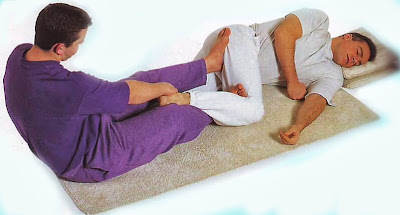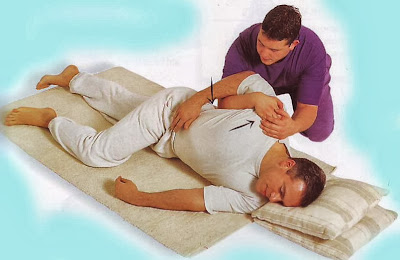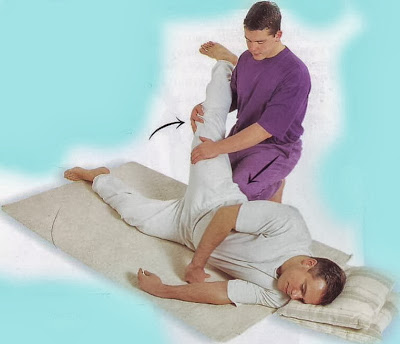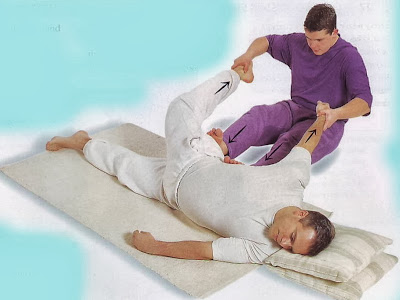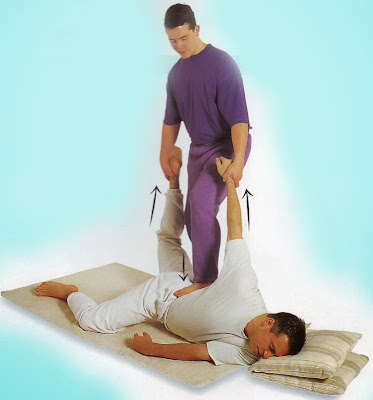3. PRESSING AROUND THE HIP
JOINT
With your partner’s right
leg still in the flexed position, press deeply with your thumbs and palms
around his hip joint. Finally elbow press by leaning in gradually with your
body weight to give more pressure.

- Wonderfully effective in
the treatment of sciatica.
4. SIDE SINGLE GRAPE PRESS
Grasp
both your partner’s ankles and use your right foot to press up and down his
thigh. Generate pressure by leaning back and pulling both his legs.

- Eases hip pain.
- Encourages relaxation of the hamstring muscles.
5. SIDE SINGLE GRAPE PRESS & TWISTED VINE
As you complete the
previous technique, tuck your foot behind your partner’s right knee and cross
his right foot over your right shin. Tuck his toes in behind your knee, holding
his heel with your right hand. Press up and down his thigh using your left
foot.
6. SIDE Z-STOP

- Wonderful for troublesome
hamstring muscles; sciatic pain felt deeply within the leg also responds well
to these treatments.
- Leaves the leg suffused
with warmth and feeling really light.
7. FOOT PRESSING THIGHS &
CALVES WITH CHAIR
Use a chair to provide you
with support as you very carefully step onto the lower part of your partner’s
flexed legs only, as shown. Without moving the position of your feet on his
legs, slowly rock from one foot to the other. Now move your feet to a new
position and then repeat.

- Relaxes tense and sore
muscles and tendons; eases sciatic pain.

- 3. PRESSING AROUND THE HIP JOINT
Pressed: Gluteus maximus, biceps
femoris, rectus femoris, tensor fasciae latae
- 4. SIDE SINGLE GRAPE PRESS
Pressed: Hamstrings, gluteus maximus,
adductors, gracilis
- 5. SIDE SINGLE GRAPE PRESS & TWISTED
VINE
Pressed: Hamstrings, gluteus maximus,
adductors, gracilis
Stretched: Quadriceps
Pressed: Hamstrings, quadriceps
- 7. FOOT PRESSING THIGHS & CALVES
WITH CHAIR
Pressed: Gastrocnemius, soleus,
hamstrings
Do not attempt this
exercise on someone who is lighter than you.
8. PRESSING THE BACK IN THE
SIDE POSITION
Touch Method One:
Palmar Pressing Kneel behind your partner and make sure
that his left leg is flexed in front of him to give good support when pressure
is applied to his back. Palm press along the two Sen channels to the left of
his spine with a rocking movement.
Touch Method Two:
Thumb Pressing Now thumb walk sideways along the same Sen
channels on your partner’s back.
- Pushes the muscles away
from the spine, relieving back pain and tension; stimulates energy flow in the
Sen benefiting internal organs.
9. ROTATING THE SHOULDER
Grasp your partner’s right
shoulder firmly with both your hands. Rotate his shoulder according to his
flexibility. Ideally, the rotation should utilize the full range of mobility
available to you.

- Restores shoulder mobility.
10. ROTATING THE SHOULDER WITH
ELBOW LEVER
Maintain your grasp on your
partner’s right shoulder and place your right elbow on his lower back to the
right of his spine. Lean forwards so that you can use your elbow as a lever
against which you can pull his shoulder as you rotate.

- Improves shoulder mobility
and eases shoulder pain.
- Relieves pain and tension
between the shoulder blades.
11. PRESSING THE KNEE-SUPPORTED
ARM
Extend your partner’s right
arm and lay it across your left knee. Then palm up and down his arm slowly and
firmly several times. Using your right hand press his axilla while
simultaneously pulling his arm back.

- Stretches the pectoral
muscles and assists myofascial release in the deltoid and biceps muscles.

- 8. PRESSING THE BACK IN THE SIDE POSITION
Pressed: Erector spinae, latissimus
dorsi, gluteus maximus, quadratus lumborum, trapezius, infraspinatus,
rhomboideus major & minor
Stretched: Upper trapezius,
pectoralis major, infrapinatus, rhomboideus minor & major
- 10. ROTATING THE SHOULDER WITH ELBOW
LEVER
Stretched: Pectoralis major,
trapezius, sternocleidomastoid, levator scapulae
Pressed: Biceps, deltoid, flexor
muscles of the wrists & hands
12. STRETCHING THE VERTICAL ARM
SIDEWAYS
Holding
your partner’s right hand and wrist, tuck the outside of your lower right leg
snugly against your partner’s back across the shoulder blades. As you lean
back, pull vertically upwards and backwards on his arm, which will be stretched
against the outer margin of you right leg. Hold the extreme position for a few
seconds and then relax. Repeat several times.
- Improves shoulder mobility.
- Eases tension and pain in the elbow region.
13. PULLING THE ARM IN THE SIDE
POSITION
Change your position to
pull your partner’s arm right back over his head. Relax and then repeat this
technique two or three times holding the extreme position in each instance for
a few seconds.

- Opens up the shoulder and
elbow joints and stimulates the circulation of blood and lymph.
- Aids and maintains joint mobility
which is especially beneficial for frozen shoulders and tennis elbow.
14. PRESSING THE ARM AGAINST
THE SIDE
Lay your partner’s right
arm along his side. Press with both hands along the outer Sen channels of his
arm. Then thumb walk the Sen channels. Finally, press his wrist and shoulder to
give the arm a stretch.

- Stimulates the flow of
energy in the Sen channels which contributes to overall energy balance.
15. STRETCHING THE ARM IN THE
TRIANGLE POSITION
Flex your partner’s arm at the elbow and place his hand
behind his head with his fingers directed towards his shoulder. Palm the
exposed upper arm and along the side of his body to the hips. Stretch the side,
pressing the elbow and hip.

- Stretches muscles down the
side of the body that rarely experience any strong extension.
16. SHOULDER TO OPPOSITE KNEE
SPINAL TWIST
With your left hand on your
partner’s right shoulder and your other hand on his right knee, press down and
outwards carefully to generate a good stretch with a twisting action on his
spine. Hold the twist for a few seconds.

- Aids spinal flexibility and
eases back pain.

- 12. STRETCHING
THE VERTICAL ARM SIDEWAYS
Stretched: Pectoralis major, trapezius,
rhomboideus, teres major, intraspinatus
- 13. PULLING THE ARM IN THE SIDE POSITION
Stretched: Latissimus dorsi, teres
major, subscapularis
- 14. PRESSING THE ARM AGAINST THE SIDE
Pressed: Deltoid, biceps, triceps,
hand & wrist extensors
- 15. STRETCHING THE ARM IN THE TRIANGLE
POSITION
Stretched: Latissimus dorsi,
triceps, pectoralis major, hand & wrist flexors, abdominal obliques,
quadratus lumborum, teres major
- 16. SHOULDER TO OPPOSITE KNEE SPINAL
TWIST
Stretched: Abdominal obliques,
quadratus lumborum, gluteus maximus, pectoralis major
Pressed: Pectoralis major, vastus
lateralis, quadriceps
17. KNEE TO KNEE HIP FLEX
Step over your partner’s
left leg and position yourself with your left leg pressed tightly against his.
Hold his right ankle and tuck your right knee behind his while you press down
on his right hip. Then push forward and rock with your knee to generate a
series of strong hip flexions.

- Increases hip mobility and
eases lower back pain and sciatica.
18. STRETCHING THE CROSSED LEG
HORIZONTALLY
Straighten your partner’s
right leg across his left hip, holding his right ankle and pressing down on his
right hip. Stretch the leg by pushing it towards his head with your knee. Keep
the leg straight and only stretch as far as is comfortable.

- Improves hip flexibility;
eases sciatica and tension in the buttocks, lower back, and hamstrings.
19. KNEE PIVOT HIP STRETCH
Place your left knee in the
center of your partner’s right buttock. Grasp his right leg and pull it towards
you, using your knee as a pivot to help generate a big stretch in the muscles
at the front of the hip and thigh. Hold for several seconds. Relax slowly and
repeat once or twice.

- Eases hip pain and
sciatica.
20. SIDE BACK BOW
Seat yourself on the floor
behind your partner with your legs out-stretched. Position your feet so that
the right one is against his pelvic arch and the left one is across his lumbar
region.
Pull your partner’s arm and leg towards you, leaning
backwards to pull his back against your feet so creating a bow shape through
the arm, spine and leg. Hold this pose for a minute or more.

- Improves flexibility of the
spine in a backward direction and eases lower back pain.

- 17. KNEE TO KNEE HIP FLEX
Stretched: Gluteus maximus, rectus
femoris
Pressed: Hamstrings, gluteus
maximus
- 18. STRETCHING THE CROSSED LEG
HORIZONALLY
Stretched: Gluteus maximus,
piriformis, hamstrings, gastrocnemius, soleus
Pressed: Gluteus maximus, tensor
fasciae latae
- 19. KNEE PIVOT HIP STRETCH
Stretched: Quadriceps, gracilis,
Sartorius, adductors, iliacus, psoas major
Pressed: Gluteus maximus
Stretched: Quadriceps, psoas major,
iliacus, rectus abdominis, pectoralis major
Pressed: Erector spinae, gluteus
maximus
21. LATERAL SCISSOR STRETCH
Assume a standing position
behind your partner and hold his right arm and leg as shown. Place the arch of
your left foot across the top of his right buttock. Maintain only a slight
tension on his arm, but pull and lift his leg towards you countering the
movement with downward pressure from your foot. Do not press too hard. When you
have achieved the appropriate degree of stretch, hold the position for ten
seconds.

- Treats hip pain, sciatica
and pain down the side of the leg, also lower back pain.
- Improves spinal
flexibility.
For very stiff people, just
lifting the leg and arm without using your foot will produce a powerful not to
overdo the stretching movements.
22. CROSSED SCISSOR STRETCH
Still holding your
partner’s right arm, change your position so that you are holding his left leg
and move your foot slightly away from his buttock to his extreme lower back.
Repeat the stretch as described in the last exercise.

- As lateral Scissor Stretch
(above).
23. PULLING SPINAL TWIST
Put your right knee into
your partner’s right buttock while pulling his left arm by leaning backwards
with your body weight. Hold for a few seconds, release slowly and repeat once
or twice.
24. LIFTING SPINAL TWIST
Bend your partner’s right
leg to form a 90˚-angle in front of him, tuck your right foot under the flexed
knee and place your left foot on the mat behind him so that the inner margin of
your lower leg is firmly against his lower back.
Hold his left wrist as
shown and lean backwards using your weight to lift him. Hold for several
seconds before lowering him gently to the floor. Repeat twice.


- Exercises 23 and 24 stretch
the muscles between the shoulders and help to ease frozen shoulders and tennis
elbow.
This exercise must not be
practiced on anyone who has had spinal surgery such as lumbar fusion or
laminectomy, those with osteoporosis or anyone who is much heavier than
yourself.

- 21. LATERAL SCISSOR STRETCH
Stretched: Rectus abdominis,
iliacus, psoas major, adductors, pectoralis major, sartoriu
Pressed: Vastus lateralis
- 22. CROSSED SCISSOR STRETCH
Stretched: As Lateral Scissor
Stretch
Pressed: Vastus lateralis
Pressed: Gluteus maximus
Stretched: Quadratus lumborum,
trapezius, teres major, orector spinae, deltoid, rhomboideus minor & major, intraspinatus, subcapularis
Stretched: Quadratus lumborum,
trapezius, teres major, erector spinae, rhomboideus major & minor,
infraspinatus, subcapularis
































